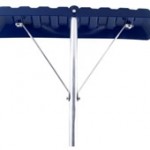 Snow buildup on roofs can be a catastrophic problem if it is allowed to accumulate unchecked. Heavy snows, especially when followed by rain, or melting-freezing cycles can lead to ice dams, which then in turn act as a retainer for the melting snow. This cycle creates a situation where the weight of the snow and ice cannot be alleviated because of the retaining occurring at the roof edges. Flat roofs suffer even more, as the water has no chance of escaping before refreezing.
Snow buildup on roofs can be a catastrophic problem if it is allowed to accumulate unchecked. Heavy snows, especially when followed by rain, or melting-freezing cycles can lead to ice dams, which then in turn act as a retainer for the melting snow. This cycle creates a situation where the weight of the snow and ice cannot be alleviated because of the retaining occurring at the roof edges. Flat roofs suffer even more, as the water has no chance of escaping before refreezing.
There a few methods of attacking the snow and ice buildup- physical removal by shovel or snowblower, deicing compounds, and use of a roof rake or similar tool to attack from ground level. Depending on the type of roof, the pitch of the roof and the amount of winter weather, a particular snow and ice removal method or combination of methods bay be appropriate.
Keeping your gutters clean is an important first step in prevention of the problem. Removal of debris allows water to flow before freezing tempatures occur. Additionally, homeowners may elect to proactively install gutter heating elements- these electrically powered wires are laid in the gutters and will heat when powered, melting ice and allowing the water to flow out.
With a flat roof, the choice is obvious- use a shovel or snowblower to get now off the roof. Tarps can help with this job, but it becomes an effort that requires more then one person. A light snowblower, such as one of the single stage models, can be lifted onto the roof as an option. Hauling up a 2 stage machine is probably not an optimal solution, as the weight of the unit makes this hard to accomplish.
 Removing snow and ice from pitched roofs employs a slightly different strategy. Using a snow roof rake immediately after a storm is the best bet– hit the snowpack before it settles in and the job can be done with relative ease. If you cant reach the entire roof, try and focus efforts on the snow near the gutters. Using a shovel is another option. but the pitch of the sloped roof can make this treacherous or even impossible.
Removing snow and ice from pitched roofs employs a slightly different strategy. Using a snow roof rake immediately after a storm is the best bet– hit the snowpack before it settles in and the job can be done with relative ease. If you cant reach the entire roof, try and focus efforts on the snow near the gutters. Using a shovel is another option. but the pitch of the sloped roof can make this treacherous or even impossible.
Tools that may aid with snow removal
Attacking the ice dam buildup at the edges is a common strategy. Using a hammer, the ice can be chipped away, but be sure to take care not to puncture or compress the gutters themselves. Some professionals first salt the ice, making it softer and easier to remove.
Using deicing agents can also help remove snow from a roof. Manufacturers use different strategies with this- filling nylon stockings with calcium chloride and placing them on the roof, using pellets designed to be thrown from the ground to the roof, or using a salt spreader to distribute ice removal agents across the roof surface. If you are considering any of these strategies, make sure the ice dams are broken enough to allow the snow melt to escape.
Safety First. Ice is slippery, and being up on a roof or ladder compounds the problem. Pulling snow and ice off the roof with a roof rake also pulls the snow towards you. Working carefully and slowly is the best advice. Snow removal is also exausting work. Take frequent breaks and try not to over exert yourself. If the job is too much to accomplish, get some help or hire a pro.
Hiring a professional service may be the safest option for removing snow from a roof. Snow and ice removal professionals can be contacted, as can professional roofing companies. The professional roofers typically have the most experienced workers and the correct insurance for this type of work, and are typically slower in the winter months. Snow and ice management companies may also offer this type of service, but make sure to do you due diligence when calling a prospective company.
